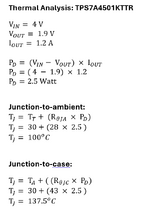engr_joni_ee
Advanced Member level 3
I did calculation for thermal analysis of TPS7A4501KTTR.
I am not sure which thermal resistance should I use in formula, junction-to-case or junction-to-ambient ?
If I use thermal resistance junction-to-case (43 C) then I get junction temperature = 137 C and
if I use thermal resistance junction-to-ambient (28 C) then I get junction temperature = 100 C.

I am not sure which thermal resistance should I use in formula, junction-to-case or junction-to-ambient ?
If I use thermal resistance junction-to-case (43 C) then I get junction temperature = 137 C and
if I use thermal resistance junction-to-ambient (28 C) then I get junction temperature = 100 C.


